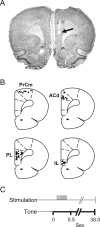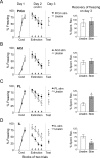Microstimulation reveals opposing influences of prelimbic and infralimbic cortex on the expression of conditioned fear
- PMID: 17142302
- PMCID: PMC1783626
- DOI: 10.1101/lm.306106
Microstimulation reveals opposing influences of prelimbic and infralimbic cortex on the expression of conditioned fear
Abstract
Recent studies using lesion, infusion, and unit-recording techniques suggest that the infralimbic (IL) subregion of medial prefrontal cortex (mPFC) is necessary for the inhibition of conditioned fear following extinction. Brief microstimulation of IL paired with conditioned tones, designed to mimic neuronal tone responses, reduces the expression of conditioned fear to the tone. In the present study we used microstimulation to investigate the role of additional mPFC subregions: the prelimbic (PL), dorsal anterior cingulate (ACd), and medial precentral (PrCm) cortices in the expression and extinction of conditioned fear. These are tone-responsive areas that have been implicated in both acquisition and extinction of conditioned fear. In contrast to IL, microstimulation of PL increased the expression of conditioned fear and prevented extinction. Microstimulation of ACd and PrCm had no effect. Under low-footshock conditions (to avoid ceiling levels of freezing), microstimulation of PL and IL had opposite effects, respectively increasing and decreasing freezing to the conditioned tone. We suggest that PL excites amygdala output and IL inhibits amygdala output, providing a mechanism for bidirectional modulation of fear expression.
Figures




Similar articles
-
Trace Fear Conditioning Differentially Modulates Intrinsic Excitability of Medial Prefrontal Cortex-Basolateral Complex of Amygdala Projection Neurons in Infralimbic and Prelimbic Cortices.J Neurosci. 2015 Sep 30;35(39):13511-24. doi: 10.1523/JNEUROSCI.2329-15.2015. J Neurosci. 2015. PMID: 26424895 Free PMC article.
-
Neurons in medial prefrontal cortex signal memory for fear extinction.Nature. 2002 Nov 7;420(6911):70-4. doi: 10.1038/nature01138. Nature. 2002. PMID: 12422216
-
Sustained conditioned responses in prelimbic prefrontal neurons are correlated with fear expression and extinction failure.J Neurosci. 2009 Jul 1;29(26):8474-82. doi: 10.1523/JNEUROSCI.0378-09.2009. J Neurosci. 2009. PMID: 19571138 Free PMC article.
-
Learning-induced intrinsic and synaptic plasticity in the rodent medial prefrontal cortex.Neurobiol Learn Mem. 2020 Mar;169:107117. doi: 10.1016/j.nlm.2019.107117. Epub 2019 Nov 23. Neurobiol Learn Mem. 2020. PMID: 31765801 Free PMC article. Review.
-
Prefrontal mechanisms in extinction of conditioned fear.Biol Psychiatry. 2006 Aug 15;60(4):337-43. doi: 10.1016/j.biopsych.2006.03.010. Epub 2006 May 19. Biol Psychiatry. 2006. PMID: 16712801 Review.
Cited by
-
Single prolonged stress disrupts retention of extinguished fear in rats.Learn Mem. 2012 Jan 12;19(2):43-9. doi: 10.1101/lm.024356.111. Print 2012 Feb. Learn Mem. 2012. PMID: 22240323 Free PMC article.
-
Anatomical substrates for direct interactions between hippocampus, medial prefrontal cortex, and the thalamic nucleus reuniens.Brain Struct Funct. 2014 May;219(3):911-29. doi: 10.1007/s00429-013-0543-5. Epub 2013 Apr 10. Brain Struct Funct. 2014. PMID: 23571778 Free PMC article.
-
Ex Vivo Optogenetic Dissection of Fear Circuits in Brain Slices.J Vis Exp. 2016 Apr 5;(110):e53628. doi: 10.3791/53628. J Vis Exp. 2016. PMID: 27077317 Free PMC article.
-
Fear signaling in the prelimbic-amygdala circuit: a computational modeling and recording study.J Neurophysiol. 2013 Aug;110(4):844-61. doi: 10.1152/jn.00961.2012. Epub 2013 May 22. J Neurophysiol. 2013. PMID: 23699055 Free PMC article.
-
Role of Amygdala-Infralimbic Cortex Circuitry in Glucocorticoid-induced Facilitation of Auditory Fear Memory Extinction.Basic Clin Neurosci. 2022 Mar-Apr;13(2):193-205. doi: 10.32598/bcn.2021.2161.1. Epub 2022 Mar 1. Basic Clin Neurosci. 2022. PMID: 36425953 Free PMC article.
References
-
- Akirav I., Raizel H., Maroun M. Enhancement of conditioned fear extinction by infusion of the GABA agonist muscimol into the rat prefrontal cortex and amygdala. Eur. J. Neurosci. 2006;23:758–764. - PubMed
-
- Amat J., Baratta M.V., Paul E., Bland S.T., Watkins L.R., Maier S.F. Medial prefrontal cortex determines how stressor controllability affects behavior and dorsal raphe nucleus. Nat. Neurosci. 2005;8:365–371. - PubMed
-
- Baeg E.H., Kim Y.B., Jang J., Kim H.T., Mook-Jung I., Jung M.W. Fast spiking and regular spiking neural correlates of fear conditioning in the medial prefrontal cortex of the rat. Cereb. Cortex. 2001;11:441–451. - PubMed
Publication types
MeSH terms
Grants and funding
LinkOut - more resources
Full Text Sources
Other Literature Sources
